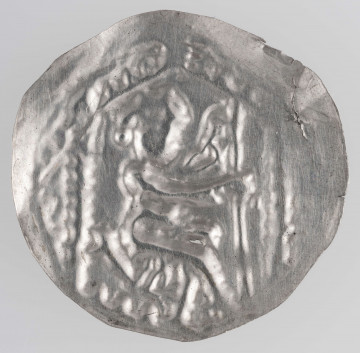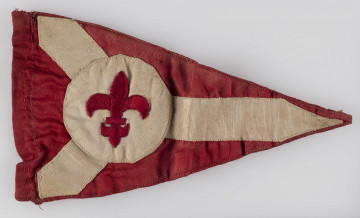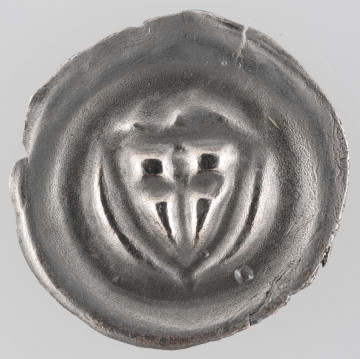
Bracteate - undefined ruler
1190 — 1210
National Museum in Lublin
Part of the collection: Money on Polish territory in the Middle Ages
From the end of the 1230s, the fourth generation of dukes came to power in Poland, divided into districts. In Greater Poland it was represented by the brothers Przemysł I (born around 1220-1221) and Bolesław the Pious (born around 1224-1227). At that time, the idea of the senior prince ruling over Lesser Poland and endowed with a set of reserved powers and privileges was a relict. In the last decades of the 12th century, the exclusive right to issue money ascribed to him became the domain of regional rulers, with time leading to the disintegration of Poland into many monetary provinces.
Two issues of denars are connected to the period of co-rulership in Wielkopolska by princes Przemysł I and Bolesław. On the obverse of the first one, we can see a figure of a kneeling knight with a sword, and on the reverse a head with carefully combed long hair. The subject of the obverse of the next denarius is the image of a prince in majesty and the bust of St Wacław on the reverse. Simultaneously with the bilateral denars minted with the obverse and reverse stamp, single-sided denars were issued in 13th-century Poland, made on very thin sheet metal (Latin bractea), hence called brakteates. The progressive devaluation of money at that time led to a decrease in the weight of minted coins, which in the middle of the 13th century usually did not exceed 0.2 grams. However, brakteates were not as small a monetary unit as it might seem, for in the middle of the 13th century two such coins were sufficient to cover the cost of a day's food.
An example of this type of issue is the brakteat of Bolesław the Pious, produced after 1257, in the period of his independent rule. It shows the bust of a knight in a helmet facing right, surrounded by a wall with a gate and two towers, with a banner between them. It is interesting that next to the variant presented here without inscriptions, there are copies with horizontally composed letters – BOL, probably referring to the person of the prince.
The depiction of the prince in armour with a pennant on the coin against the background of the wall served to manifest his sovereign territorial power, emphasised his knightly qualities and defensive abilities. It also indicated the importance of the castle from which he ruled the country.
Tomasz Markiewicz
Author / creator
Dimensions
cały obiekt:
Object type
numismatic
Technique
stamp minting
Material
silver
Creation time / dating
Creation / finding place
Owner
The National Museum in Lublin
Identification number
Location / status

1190 — 1210
National Museum in Lublin

16285
National Museum in Lublin

1301 — 1400
National Museum in Lublin
DISCOVER this TOPIC
Museum of King Jan III's Palace at Wilanów
DISCOVER this PATH
Educational path